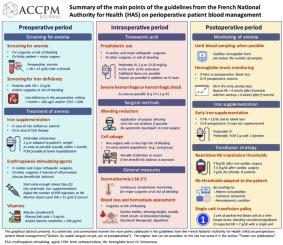围手术期患者血液管理(不包括产科):法国国家卫生局指南》。
IF 3.7
3区 医学
Q1 ANESTHESIOLOGY
引用次数: 0
摘要
法国国家卫生局(HAS)最近发布了外科手术患者血液管理(PBM)指南。这些建议基于 PBM 的三大支柱:优化红细胞质量、减少失血量和优化贫血耐受性。在术前阶段,这些指南建议检测贫血和缺铁情况,并尽可能在手术前采取纠正措施,以防手术有中度至高度出血风险或已知术前贫血。在术中,如果出血风险较高或出现大出血,建议使用氨甲环酸和一些外科技术来限制出血;在一些有较大输血风险的手术中,建议使用细胞挽救术。在术后,建议限制血液样本,但必须对术后贫血进行监测,这可能会导致采取纠正措施(尤其是静脉注射铁剂)或对这种贫血进行更精确的诊断评估。考虑到合并症,最重要的是考虑到患者的耐受性,建议术后采用 "限制性 "输血阈值。建议医疗机构在整个围手术期实施患者血液管理策略和计划,以减少输血和缩短住院时间。本文介绍了 HAS 建议的英文译文以及这些建议的基本原理。本文章由计算机程序翻译,如有差异,请以英文原文为准。

Perioperative Patient Blood Management (excluding obstetrics): Guidelines from the French National Authority for Health
The French National Authority for Health (HAS) recently issued guidelines for patient blood management (PBM) in surgical procedures. These recommendations are based on three usual pillars of PBM: optimizing red cell mass, minimizing blood loss and optimizing anemia tolerance. In the preoperative period, these guidelines recommend detecting anemia and iron deficiency and taking corrective measures well in advance of surgery, when possible, in case of surgery with moderate to high bleeding risk or known preoperative anemia. In the intraoperative period, the use of tranexamic acid and some surgical techniques are recommended to limit bleeding in case of high bleeding risk or in case of hemorrhage, and the use of cell salvage is recommended in some surgeries with a major risk of transfusion. In the postoperative period, the limitation of blood samples is recommended but the monitoring of postoperative anemia must be carried out and may lead to corrective measures (intravenous iron in particular) or more precise diagnostic assessment of this anemia. A “restrictive” transfusion threshold considering comorbidities and, most importantly, the tolerance of the patient is recommended postoperatively. The implementation of a strategy and a program for patient blood management is recommended throughout the perioperative period in healthcare establishments in order to reduce blood transfusion and length of stay. This article presents an English translation of the HAS recommendations and a summary of the rationale underlying these recommendations.
求助全文
通过发布文献求助,成功后即可免费获取论文全文。
去求助
来源期刊

Anaesthesia Critical Care & Pain Medicine
ANESTHESIOLOGY-
CiteScore
6.70
自引率
5.50%
发文量
150
审稿时长
18 days
期刊介绍:
Anaesthesia, Critical Care & Pain Medicine (formerly Annales Françaises d''Anesthésie et de Réanimation) publishes in English the highest quality original material, both scientific and clinical, on all aspects of anaesthesia, critical care & pain medicine.
 求助内容:
求助内容: 应助结果提醒方式:
应助结果提醒方式:


